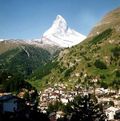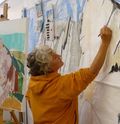Telluride local instructs at Michigan Ice Fest
by Ben Clark
 Flying into Marquette, MI late on a Thursday night in February was about as exotic as my life could get. I'm a climber from Colorado and heard there was ice here, in the cold and windswept upper peninsula. Not just normal ice of course, ice that had drawn climbers to the region for a climbing festival running into its 26th year. Really???
Flying into Marquette, MI late on a Thursday night in February was about as exotic as my life could get. I'm a climber from Colorado and heard there was ice here, in the cold and windswept upper peninsula. Not just normal ice of course, ice that had drawn climbers to the region for a climbing festival running into its 26th year. Really???
For all the promise of cold, it was the warmth of the locals that made the trip so worthwhile. Heading out to Sand Point on Friday with Rep Bryan Kuhn and his friends, I was treated to thunker swings in a savory pillar of steep waterfall ice. We shared it with several locals, looking to experience the privacy that makes ice climbing so cherished in this region about to be inundated by weekend festivities. I was psyched to be there and happy to be surrounded by such nice people.







